1984 Audi 4000S Quattro: Put Your Mind at Ease

From the March 1984 issue of Car and Driver.
After years of telling the world that front-wheel drive was the hottest tip since Secretariat in the Triple Crown, Audi suddenly began to beat the four-wheel-drive drum for all they were worth. When the original Quattro turbo coupe appeared in Europe, hoopla was piled atop hype until even the most objective observers could scarcely see the truth. Would the driving of all four wheels prove so far superior that anyone without it would simply be left floundering?
As Audi patted itself on the back and laid plans to convert its entire line of already excellent hardware to four-wheel drive, the first turbo Quattros arrived in the United States (C/D, June 1982). Compared with European Quattros, they offered less horsepower, slightly softened running gear, and a penchant for being even trickier to drive. Quattros certified for sale in America also arrived with price tags bloated to the $37,000 plateau, and droves of potential buyers decided to make do with so-called lesser (and certainly less expensive) machinery.
Aaron Kiley|Car and Driver
Welcome to the second round of four-wheel-drive fanfare. Audi’s “S” designation in “4000S Quattro” could stand for “Son of Quattro.” The turbocharged Quattro coupe continues as the ne plus ultra of transport for the beautiful ski people, while the 4000S Quattro, true to Audi’s promise, dips closer to regular folks’ status. It offers the new 5000’s normally aspirated engine, the 4000’s glassy-sedan configuration, and a price tag only half as steep as that of the turbo coupe. The 4000S Quattro is not only far and away a better dollar deal than the coupe but a better-balanced car in the bargain. Does this mean four-wheel drive should be summarily bolted into every car designed from this day forward? We shall see.
Before we can view this bigger picture, we must view Audi’s application in the context of sports-sedandom. The action here is hot and heavy. Cars like the BMW 318i, the Chevrolet Celebrity Eurosport, the Dodge 600ES Turbo, the Mercedes-Benz 190E, the Pontiac 2000 Sunbird Turbo, the Pontiac 6000STE, the Saab Turbo, the Volkswagen Quantum, the Volvo Turbo, and Audi’s own 4000 and 5000 tightly pack the gap from $11,000 to $25,000. This is some frisky bunch, and now here come the German techno-tweakers, Audi’s 4000S Quattro primed to redefine the sports sedan as completely as BMW’s 1600 did in the mid-Sixties. Holy traction aids!
Audi brings to battle a car that takes a sturdier stance than its front-wheel-drive 4000. On 6.0-by-14.0-inch spider-spoked wheels (the same pattern as the inch-taller alloys on the turbo Quattro, which also carries tires one size bigger), the four-door sports 195/60R-14 Firestone S-660s. The leading and trailing edges of our test car are sculptured with an air dam and a rear spoiler, and screaming-red paint vacuum-wraps the trim shape of Giorgetto Giugiaro’s original 4000 (even if it is aging quickly alongside Audi’s own ultra-aerodynamic 5000). Wide side moldings and an abundance of matte-black trim pay homage to the modern German design ethic.
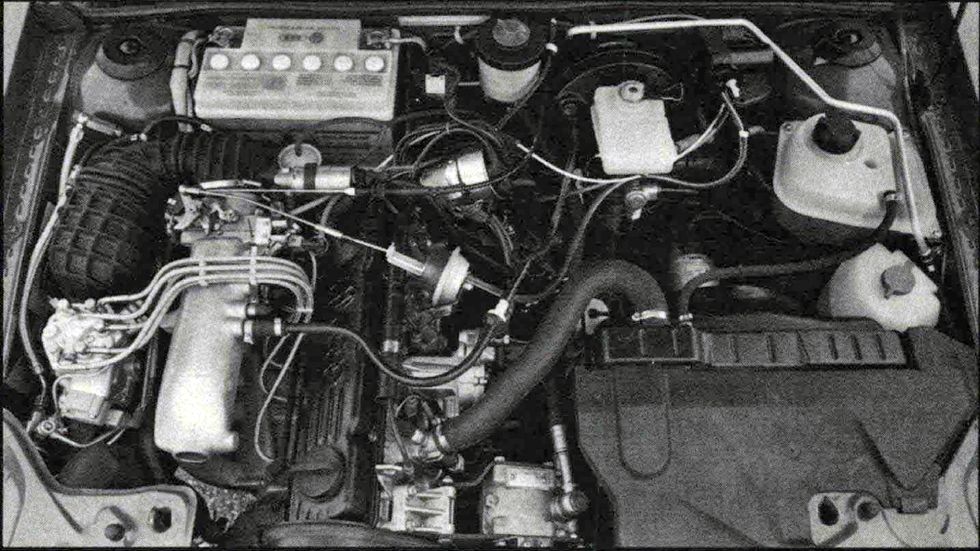
Aaron Kiley|Car and Driver
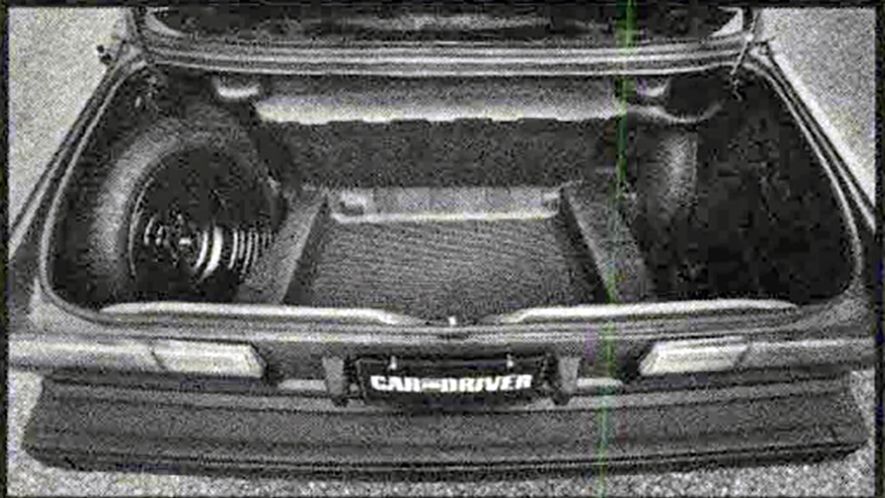
Aaron Kiley|Car and Driver
Looking in through the tinted glass as you unlock the door, further matte black awaits you, from the leather-wrapped, four-spoke wheel to a roomy and comfortable back seat. The upholstery is a dusky velour with a warm brownness that appears pure black in dim light. Comfort up front is decent, if lacking in ultimate lateral support. The bolsters are good along the lower torso but erode too much up higher. Audi uses a single lever to control both the height and inclination of the lower cushion; in this respect, Japanese technology is considerably more advanced. The Quattro’s gauges are lighted in red in order not to interfere with eyes adjusted to headlight brightness (which is good on high beam, not so hot on low), though this can be an annoyance to drivers with a low sensitivity to red. The information array consists of a big tach, a big speedo, smaller temp and fuel gauges, and a clock.
Power windows and mirrors are standard, as are cruise control and an electronic “Audi Design” AM/FM/cassette stereo system. Buttons for the windows and radio are either poorly located or too small to use easily, but the functioning of the windows and the sound quality are both fine. Not so the standard air-conditioning system, which is very slow to react to changes in settings and varies widely in effectiveness with the car’s speed. The windshield wipers, on the other hand, are probably the smoothest we’ve encountered on a German car. An exquisitely clever touch is visible to followers on frosty mornings: the lower bands of the rear-defogger wiring spell out “Quattro.”
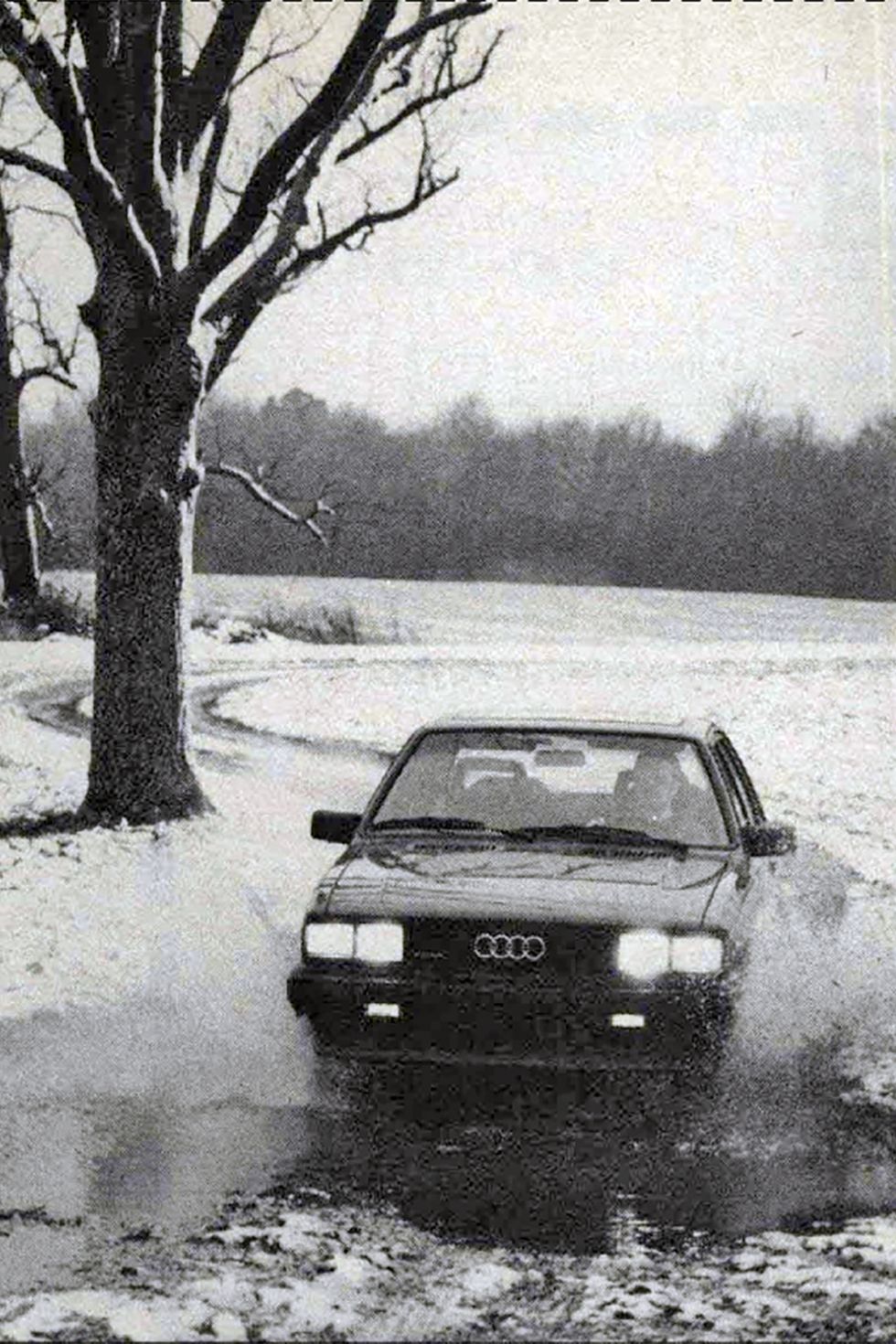
Aaron Kiley|Car and Driver
The variable-assist power steering makes light work around town but firms up at higher speeds, transmitting excellent feel. The shift linkage is light and generally accurate (except for reverse), and the pedal placements have been improved, easing heel-and-toe effort. The braking feel has been freed of the sponginess that’s plagued Audis for years. There are discs on all four wheels (two more than on the regular 4000), and those in front are vented. The brakes exhibit moderate fade, but they also produce good balance and control and very short stops.
More Archive Audi Reviews
Welcome back to the running-gear department. Up front, the uprated version of Audi’s five-cylinder engine brings to bear an additional 15 horsepower. Our testing, however, indicates that the power increase is more than offset by the extra weight of the 4WD powertrain. Comparing the two-wheel-drive, 2450-pound 5+5 we tested almost three years ago with the 2820-pound Quattro of today, 0-to-60-mph times have increased from 9.6 to 10.1 seconds. This isn’t really slow, but it’s less than the 2.2-liter’s new KE continuous fuel injection and electronic mixture actuator might lead you to expect, as are the quarter-mile performance of 17.3 seconds at 77 mph and the top speed of 111 mph. Neither do the engine and the close-ratio five-speed transmission make for exceptional fuel mileage, the EPA city figure of 21 mpg ranking no more than so-so in this hard-fought category.
We are less ambivalent about the Quattro’s four-wheel drive. Given slippery conditions in which to showcase its mettle, it is terrific. This four-door, because of less horsepower, better ride-motion control, and improved visibility, is considerably easier than the turbo coupe to drive smoothly. It transitions better, corners flatter, and makes its driver look better. On-board adjustments allow you to tailor its characteristics to road conditions. For best dry-weather handling, leave the console-mounted control button pushed in to take advantage of the better agility offered by the free-turning differentials. For moderately slithery conditions, pull the button out to its middle notch, locking the middle of the car’s three differentials for firmer steering, greater stability, and reduced braking distances. Pulling the button all the way to its third position locks the center and rear diffs, producing the shortest stopping distances and the impression that even standing water can’t unhinge this car’s composure.
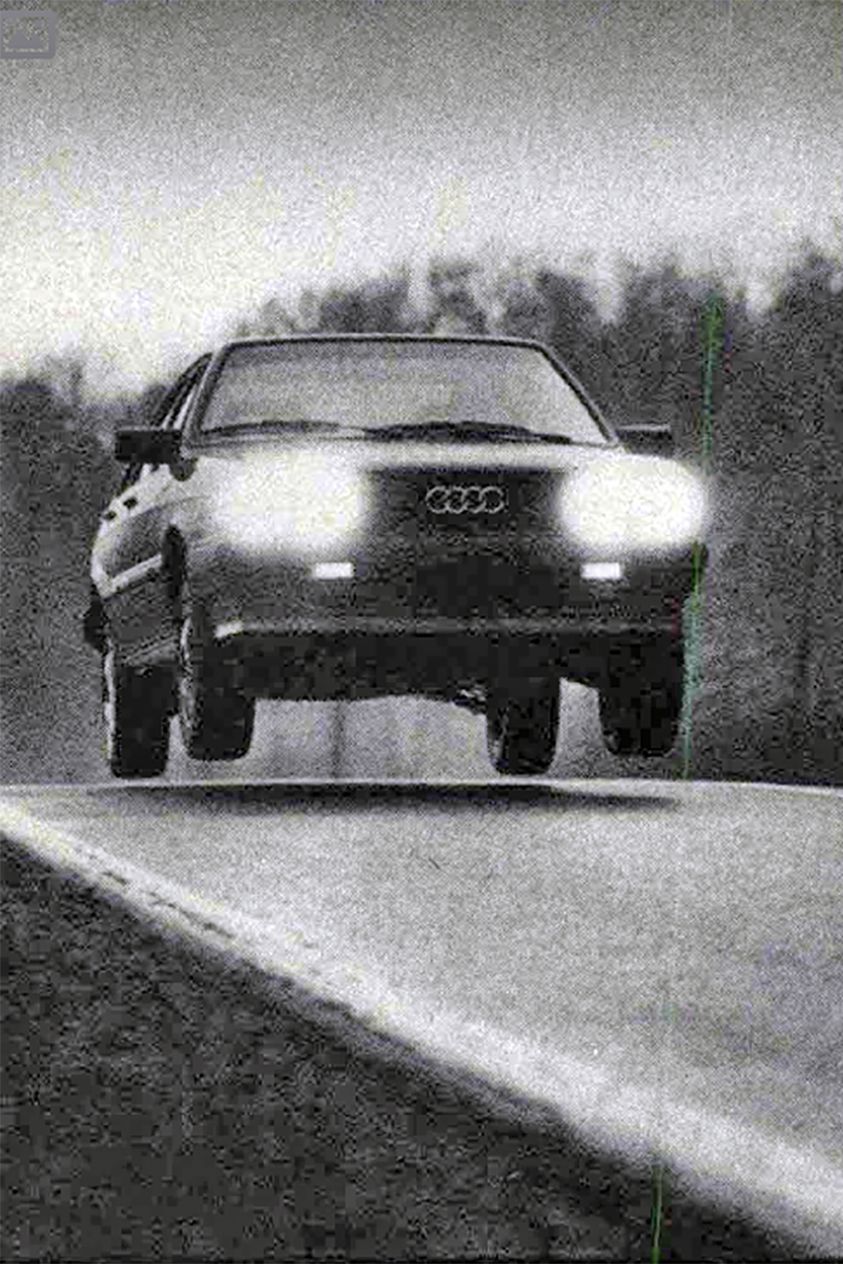
Aaron Kiley|Car and Driver
To quote Audi’s press material: “Snow-covered roads and even loose surfaces can now be negotiated easily. Most people have experienced the problem in winter when their car refuses to move, even though the engine starts readily. Or, how often is one forced to take a good run to pass another car stranded on a hill, in the hope that nothing comes the other way? These are all things of the past. There is no longer any need to maintain speed for fear of losing traction.” This, at least, is exactly true. The Quattro possesses a singular ability among sporting passenger cars to put your mind at ease. Planning a trip and bad weather’s on the way? The Quattro, for all practical purposes, eliminates the need to listen to the weather report. Suddenly, it’s a simple matter of packing the car and going, of being at ease with the tasks of dealing with road conditions and other traffic, both of which take on a new and less threatening character when viewed with the circumspect judgment afforded by the capable Quattro. It isn’t so much that the Quattro gives you a truly enormous edge over elements otherwise beyond your control; it’s that it gives you a reasonable edge, an overall stability that no rear-wheel-drive car can provide and few front-wheel-drive cars can approach. In this context, the Quattro is exactly the right answer to the question first asked by Audi and soon echoed by others—engineers, journalists, and everyday drivers alike.
Finally, there are several important things to remember. First, the Quattro can’t go around corners much, if any, faster than its rivals for the sports-sedan crown, whatever the conditions, although it can approach and leave corners more quickly when the slime is heavy on the surface. Second, the Quattro is in possession of a chassis layout that does, indeed, generally lend it greater stability than is enjoyed by some of its rivals. It is here, in the balance of the thing, that the owner of the 4000S Quattro will take the greatest pleasure in the investment of that $17,000.
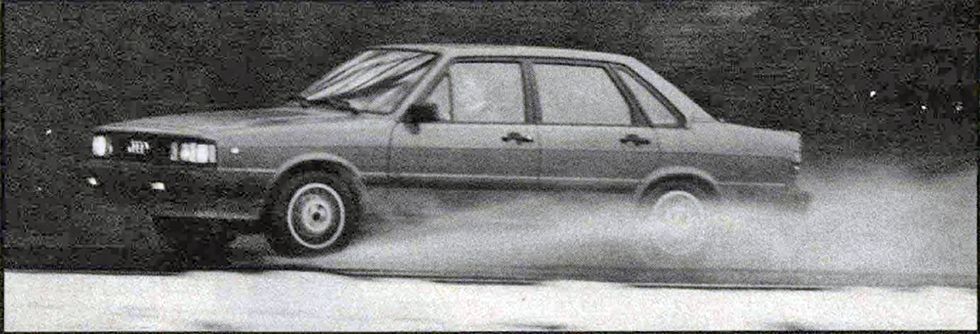
Aaron Kiley|Car and Driver
The upshot is that full-time four-wheel drive pays off for anybody who lives with really awful weather. It can also pay off for a sensitive driver who understands how to use Quattro to maintain good speed over wet roads. Otherwise, a driver would be just about as well off with, say, the front-wheel-drive 4000, from which the Quattro springs, although they wouldn’t get good wheels and tires, the better suspension rates, or the four-wheel disc brakes.
Arrow pointing downArrow pointing down
Specifications
Specifications
1984 Audi 4000S Quattro
Vehicle Type: front-engine, all-wheel-drive, 5-passenger, 4-door sedan
PRICE
Base/As Tested: $16,500/$17,000
Options: sunroof, $500.
ENGINE
SOHC inline-5, iron block and aluminum head, electronic fuel injection
Displacement: 136 in3, 2226 cm3
Power: 115 hp @ 5500 rpm
Torque: 126 lb-ft @ 3000 rpm
TRANSMISSION[S]
5-speed manual
CHASSIS
Suspension, F/R: struts/struts
Brakes, F/R: 10.2-in vented disc/9.5-in disc
Tires: Firestone S-660
195/60R-14
DIMENSIONS
Wheelbase: 99.4 in
Length: 176.6 in
Width: 66.4 in
Height: 53.8 in
Passenger Volume, F/R: 48/38 ft3
Trunk Volume: 12 ft3
Curb Weight: 2820 lb
C/D TEST RESULTS
60 mph: 10.1 sec
1/4-Mile: 17.3 sec @ 77 mph
100 mph: 48.0 sec
Top Gear, 30–50 mph: 11.0 sec
Top Gear, 50–70 mph: 11.8 sec
Top Speed: 111 mph
Braking, 70–0 mph, differentials unlocked/locked: 191/181 ft
Roadholding, 282-ft Skidpad: 0.75 g
C/D FUEL ECONOMY
Observed: 19 mpg
EPA FUEL ECONOMY
Combined/City/Highway: 24/21/28 mpg
C/D TESTING EXPLAINED



